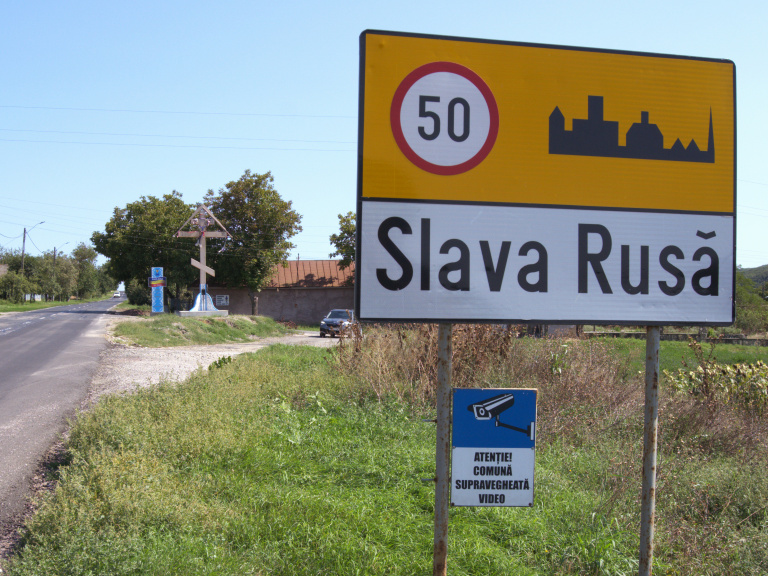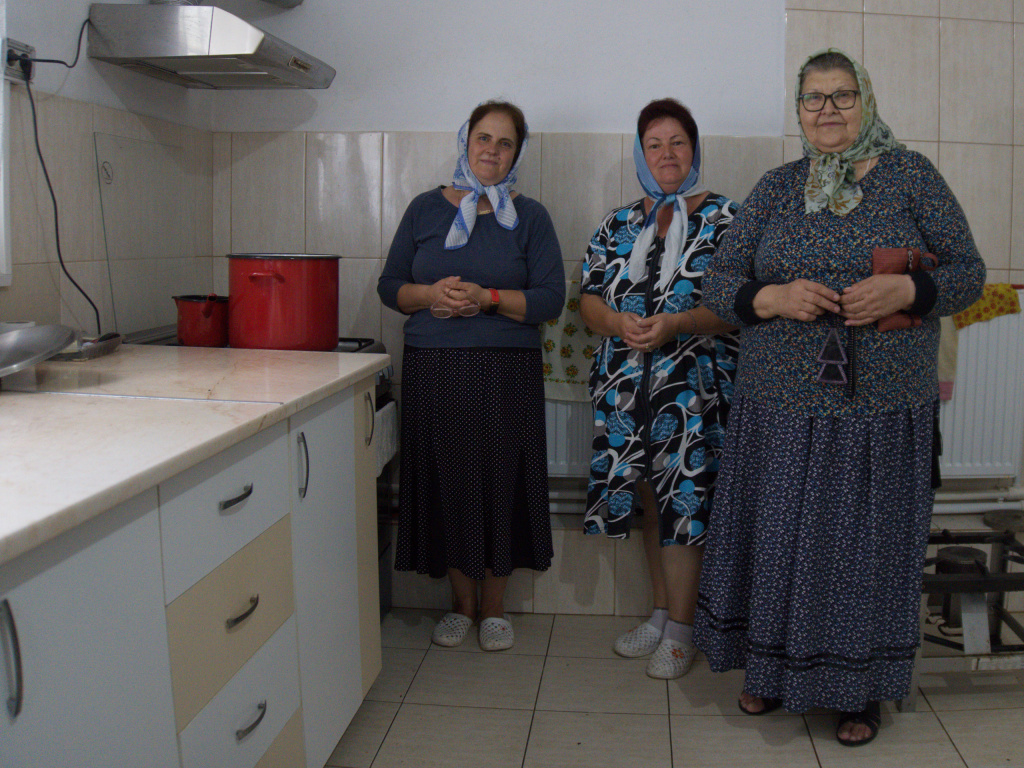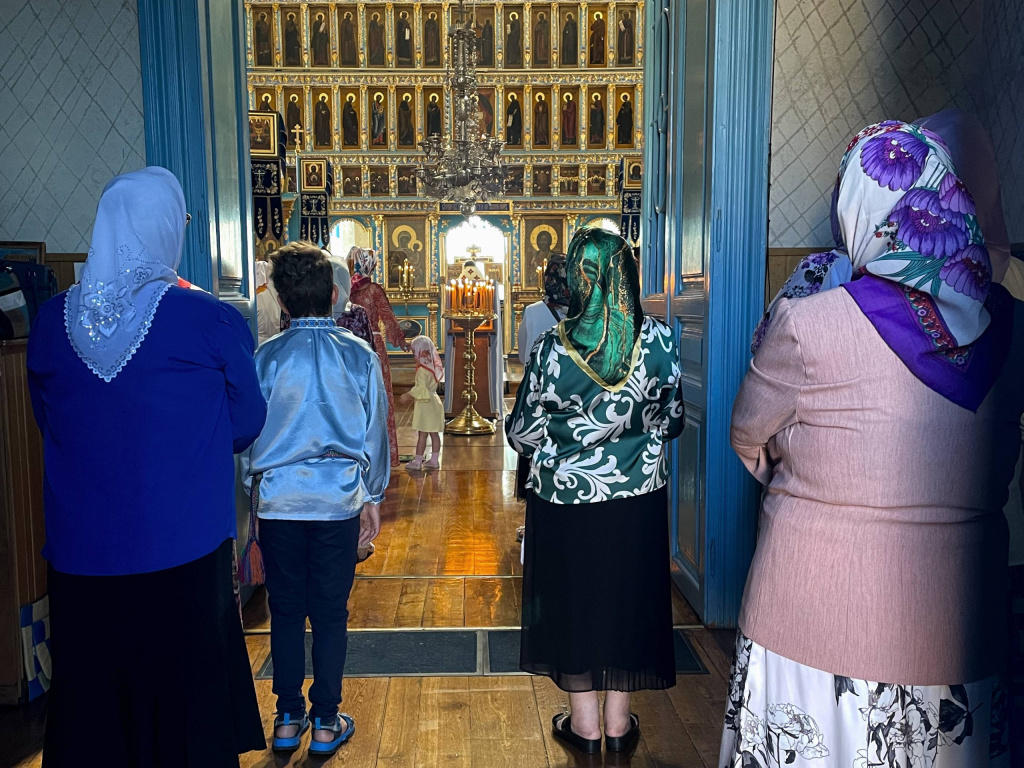Visiting the Lipovans: The Russians of Romania between tradition and future7 min read
Romania is a patchwork of national minorities, with the Hungarians and Roma being the largest. Less well-known are the Lipovans, a Russian-origin people who have maintained their traditions for centuries. Bram Jongejan reports from the Tulcea region in northeastern Romania.
Exquisite, light blue embroidery, light blue-trimmed church walls, houses plastered in pastel blue, and women in dresses of the same light blue shade. “Yes, light blue is the colour of our identity,” says a man taking a break from mowing the grass. A sweaty handkerchief is tied around his head, and behind simple glasses and a long, crumpled grey beard, a friendly face emerges.
“Come on in,” he whispers in Russian, walking towards the church. He opens the back door with a large key and steps over a wooden threshold. Inside, he points through a dull window at the beautiful altar. “We have a different Orthodox Church than the Romanians,” he explains. “We are Russian.”
The man is Lipovan, a member of Romania’s ethnic Russian minority. The Lipovans have maintained their way of life for centuries, though younger generations seem to be letting go of these traditions more and more.
Russian villages
Slava Rusă is indicated on a road sign in Romanian, meaning “Russian Glory.” The long sign is adorned with a traditional Lipovan embroidery pattern in characteristic light blue on a white background. In front of the sign stands a towering, dark wooden Orthodox cross with eight points. In Slava Rusă, more than eighty percent of the population is of Lipovan descent.
“Segregated?” the man asks. “Maybe in the past, but not anymore. Only our churches, of course, but the children go to regular schools, learning Romanian just like everyone else.” Younger generations of Lipovans are becoming more detached from Russian and increasingly use Romanian, although, according to the man, Russian is still taught in Slava Rusă.

“They learn it through the church, but not at school.” Whether this can stop the erosion of the language is questionable. He steps outside and locks the door. “Further down, you’ll find the men’s monastery and more villages.” He points down the road and restarts his lawnmower.
In the east of Romania, deep into the Danube Delta, there are several villages where the Lipovans form the majority. They established various settlements here, including the village of Jurilovca in the early nineteenth century. With golden Orthodox domes and light blue houses, you cannot miss the Lipovan influence.
Historically, Lipovans lived off fishing, but now tourism is becoming a key source of income. The vast lakes of the delta and wide fields make this region attractive to visitors and in the tourist shops near the harbour, traditional clothing with light blue embroidery — though replicated in plastic — is sold to groups of day-trippers.
Three and a half centuries of schism
The Lipovan community in Romania numbers about 23,000 people, although some estimates go as high as 100,000. This discrepancy can be explained by increasing assimilation, including mixed marriages or an inability or unwillingness to adhere to strict religious rules. These rules stem from the beliefs of the Old Believers, which form a crucial part of Lipovan identity.
The Old Believers are a splinter group which split from the Russian Orthodox Church. The schism was triggered by dissatisfaction with church reforms during 1666–1667, which had been initiated by Tsar Alexei Mikhailovich Romanov and Patriarch Nikon of Moscow. Their purpose was to align the Russian Orthodox Church with the Byzantine churches, but a portion of the faithful did not agree with these reforms and continued to follow the old rites. The result was a schism — the raskol — between the Old Believers and the reformers.
Adherence to the rituals and traditions from before the raskol led to persecution within the Russian Empire, and large groups of Old Believers were forced to flee to Siberia or settle along the Empire’s borders on the European side. Those who settled in Moldova, Ukraine, Bulgaria, and Romania called themselves Lipovans.
Commitment to traditions and religious beliefs has helped the Lipovans maintain a strong cultural identity. Their self-reliance in professions such as fishing and agriculture strengthened their isolation and resistance to modernisation. Nevertheless, modern influences, such as industrialisation during communism and contemporary globalisation, have increasingly impacted their way of life.
Old rituals
“Are you hungry?” calls a veiled woman from a distance. Here, in the village of Carcaliu, a large red pot of soup simmers on the fire in an annex to an imposing church. “It’s Wednesday, so we’re eating vegetarian soup.” She gestures for us to come further. Inside, a stout woman with a white cap and apron that once was white sits behind a long table. Bottles of water are lined up, glasses are poured. Further down, another woman ladles out soup.
That rituals play an important role is also evident here. A man in a white shirt with embroidered sleeves and a pouch at his hip grabs a glass. He makes a hasty but convincing sign of the cross, followed by a slight bow. Only then does he take a sip. Another man has a dark beard reaching his chest, and straight dark hair falling sleekly over his ears. His body is cloaked in a long dark brown robe. The three women call him otets, Russian for father.

The man tries to explain the difference between the cross of the Russian Orthodox Church and that of the Old Believers, a distinction rooted in the raskol. “We have three crossbars,” he says, while a woman struggles to demonstrate it with her fingers, then takes over the explanation. “We also have our own church school,” she adds, where children study Russian and learn about their culture and traditions.
Service by the Danube
Since 1940, the Old Believers’ headquarters has been in Brăila, along the Danube, where churches thrive on Sunday mornings, including the Lipovan church. While the morning sun reflects off the golden onion domes outside, inside the warm air trembles above a large golden candelabrum holding twenty candles. Men and boys stand near the altar. Rows of women, draped in colourful scarves of purple and green, stand behind.
Before the Molotov-Ribbentrop Pact of 1940, the Old Believers’ headquarters was in the village of Fântâna Albă in northern Bukovina, which belonged to Romania between the World Wars. Annexation of part of the region by the Soviet Union forced the Lipovan Old Believers of Fântâna Albă (later Bila Krynytsya) to flee and settle in Brăila on the Danube.

During a service in Brăila, a gentle chant fills the air as worshippers follow the priest’s lead, their melodic voices briefly interrupted by the cries of children at the back of the church. Devotees bow toward the altar in sync with the old rites, occasionally kneeling. The elderly bow as much as they can, keeping pace with the ritual’s demands.
Future and tradition
At the back of the church, a mother tries to calm her child as he moves the heavy church door with his tiny arm. She steps outside, standing near the open door, continuing to follow the service. As she soothes her child, she performs her own silent rituals, calming him until he stops crying.
Despite even the youngest being initiated into the customs and symbols, the traditional way of life is increasingly under pressure. The Romanian government supports their cultural and religious activities and has made efforts to protect their rights and autonomy. The Lipovans are recognized as a national minority in Romania, yet the erosion of their language and traditions among the younger generation seems inevitable.
Not for a boy of about ten, though, who removes his long brown coat, revealing a traditional outfit with a dark pair of trousers and a pouch at his hip. His collar and sleeves are accented with light blue embroidery. The chanting grows louder, and the priest moves across the front, swinging incense toward the altar.
This article was originally published in Dutch on 29 September 2024 by Donaustroom. The translation has been edited for length.



